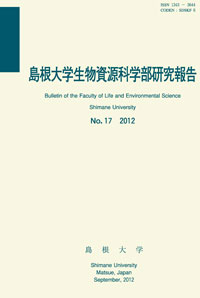島根大学生物資源科学部
ISSN:2435-0885(オンライン)
ISSN:1343-3644(冊子体)
なお、冊子体の刊行は23巻まで
ISSN:1343-3644(冊子体)
なお、冊子体の刊行は23巻まで

ダウンロード数 : ? 件
この文献の参照には次のURLをご利用ください : https://ir.lib.shimane-u.ac.jp/38169
島根大学生物資源科学部研究報告 21
2016-09-30 発行
島根大学三瓶演習林におけるコナラの直径成長
Radial growth of Quercus serrata in secondary forest in Sambe Forest, Shimane University
ファイル
内容記述(抄録等)
Mass mortality caused by oak wilt disease is spreading in secondary forests in Japan. To understand the mechanism maintaining secondary forests in succession, it is important to clarify the age structure of such forests. Therefore, 35 Quercus serrata along a forest road in a secondary forest dominated by Q. serrata in Shimane University’s Sambe Forest, including 10 live trees and 25 trees that had died of oak wilt disease, were felled at a height of 0.3 to 0.5m and the numbers of annual rings and widths every 5 years were measured. The ages of the felled Q. serrata ranged from 51 to 75 years. Although the radial growth had peaked, large individuals maintained greater growth until felled. Relatively old Q. serrata are subject to damage from oak wilt disease. When there was no damage due to oak wilt disease, the Q. serrata in the study forest could grow more because the trees that died also kept growing before the wilt disease damaged them.
About This Article
Other Article
